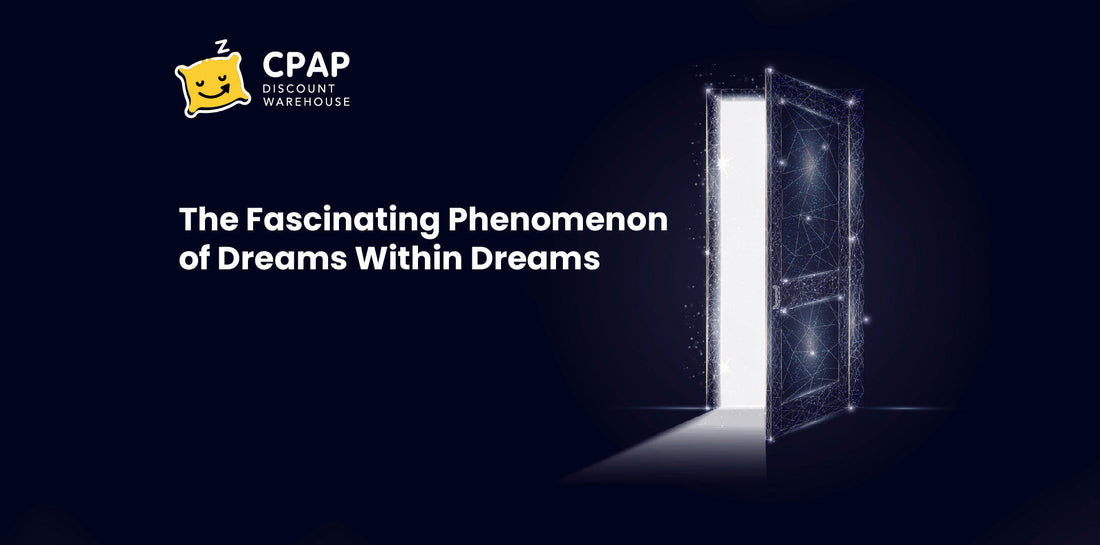Dreams including the concept of "a dream within a dream" have long been a source of intrigue, inspiration, and mystery for humans. They offer a glimpse into the subconscious mind, allowing us to explore realms of imagination and emotion that may elude us in waking life. Among the many peculiarities of dreams, one phenomenon stands out as particularly intriguing: the dream within a dream. To explore more about this captivating topic, read more in this article at CPAP Discount Warehouse and discover how better sleep can enhance your dream world!
What Is a Dream Within a Dream?
A dream within a dream, often referred to as a nested dream, is a peculiar occurrence in which a dreamer experiences the sensation of dreaming while still being within a dream. In other words, it's as if they enter a secondary dream world while they are already dreaming. This phenomenon has captured the human imagination for centuries and has been a recurring theme in literature, art, and cinema.

Layers of Consciousness
Layered consciousness refers to the idea that within a dream, a person can experience multiple levels of awareness or realities. It's as if there are different layers or levels of the dream, each with its own set of perceptions and experiences.
Primary Dream
The primary dream is the initial dream that a person experiences when they fall asleep. In this dream, they may interact with various characters and environments, just like in any typical dream.
Secondary Dream
Within the dream landscape, a secondary dream, or dream within a dream, unfolds as a captivating exploration of the subconscious, offering layers of intrigue and complexity to the dreamer's experience.
Tertiary Dream (if applicable)
In some cases, the secondary dream can give rise to yet another dream, creating a tertiary dream. This pattern can continue, with dreamers experiencing multiple layers of dreams nested within each other.


Dream layered consciousness in a dream within a dream is a phenomenon in which the dreamer is not always aware of the existence of higher level dreams, blurring the boundaries between reality and the dream world. This surreal experience can lead to introspective questions and challenge our understanding of the complexity of the human mind during sleep.
Exploring the Subconscious
Nested dreams, with their layers and intricate narratives, offer a fascinating window into the depths of the human subconscious.
-
Hidden Desires and Fears: Nested dreams unveil symbolic manifestations of hidden desires and fears from the depths of the dreamer's subconscious, providing a safe arena for exploration and introspection during slumber.
-
Symbolic Representations: Nested dreams are a canvas for the subconscious to communicate through symbols and metaphors, inviting interpretation to unveil profound insights into the dreamer's inner world.
-
Processing Complex Emotions: Nested dreams provide a unique platform for the mind to process intricate emotions, unresolved conflicts, or trauma, offering a safe and symbolic space for inner exploration and healing.
-
Self-Reflection: Nested dreams often prompt self-reflection upon waking. Analyzing the layers and their interplay can lead to a deeper understanding of one's psyche, offering insights into motivations, anxieties, and aspirations.
-
Creative Problem-Solving: Nested dreams may stimulate creative thinking as the mind explores diverse scenarios within its layers, potentially yielding innovative problem-solving in waking life.
Interpreting nested dreams can be subjective, as symbolism varies from person to person. Some seek help from dream analysts or therapists for deeper insight into their subconscious.
Literary and Cultural References
The theme of dreams within dreams has indeed captured the imagination of writers, artists, and filmmakers throughout history.
-
Edgar Allan Poe's "A Dream Within a Dream"poetically ponders the transitory nature of life, comparing it to trying to grasp sand slipping away, underscoring the fleeting quality of existence.
-
Christopher Nolan's "Inception" (2010): "Inception" is a groundbreaking film that delves into the intricacies of dream manipulation, blurring the lines between dreams and reality, and prompting profound philosophical ponderings on perception and existence.
-
Lewis Carroll's "Alice's Adventures in Wonderland" (1865): Alice's Wonderland adventures blur the line between reality and dreams, featuring a dreamlike realm with ever-changing rules and eccentric characters.
-
Salvador Dalí's Surrealist Art: Dalí's surreal art challenges reality with dreamlike, distorted imagery, often evoking nested dreams within his works.
-
H.P. Lovecraft's Cosmic Horror: Lovecraft's tales like "The Call of Cthulhu" explore dreamlike realms and human fragility when confronted with cosmic truths.
-
Kafkaesque Literature: Kafka's works like "The Metamorphosis" blur reality and the bizarre, evoking a sense of disorientation akin to nested dreams.
These references highlight the nested dreams and the deep philosophical queries they pose about reality, perception, and the human mind. Each work provides a distinct viewpoint on the intricacies of the dream realm and its connection to our waking existence.

>>> The Enigma of Zzz's: Unraveling the Puzzling World of Dreams
Lucid Dreaming and Control
Lucid dreaming and control play a fascinating role in the experience of nested dreams, where dreamers become aware that they are dreaming and can sometimes manipulate the dream's narrative.
-
Awareness of Dream State: allows individuals to be aware they're dreaming while asleep, facilitating exploration of nested dreams and transitions between dream layers.
-
Intentional Manipulation: Lucid dreamers can intentionally control and manipulate dream elements, including transitions between dream layers, providing a unique and immersive dream experience.
-
Enhanced Exploration: In a lucid dream, individuals consciously recognize they are dreaming while asleep, granting them control to manipulate dream elements and explore the subconscious through a dream within a dream.
-
Layered Dreamscapes: Advanced lucid dreamers can navigate between multiple dream layers, much like switching between different channels on a television. This skill enhances their ability to explore and harness the full potential of their dreamscapes.
-
Experimentation: Advanced lucid dreamers often use nested dreams as a canvas for creative exploration and personal growth, pushing the boundaries of what the dream world can offer.
Lucid dreaming enhances nested dream exploration through conscious awareness, enabling dreamers to delve into multiple dream layers, confront their subconscious, and engage in creative problem-solving within dreams.

>>> How Long Is a Sleep Cycle? 4 Phases of the Sleep cycle
Theories and Interpretations
Theories and interpretations of nested dreams, or dreams within dreams, have fascinated dream experts, psychologists, and scholars for years.
-
Emotional Processing: A dream within a dream can be a means of emotional processing, offering a safe space for individuals to explore complex emotions, unresolved conflicts, and hidden fears, potentially fostering psychological growth.
-
Narrative Complexity: Nested dreams highlight the brain's storytelling prowess, weaving complex narratives during sleep. They offer a glimpse into the mind's creative and narrative capabilities, intriguing dream researchers and enthusiasts alike.
-
Subconscious Exploration: Nested dreams offer a window into the subconscious, revealing hidden desires and fears for self-discovery and insight.
-
Memory Consolidation: Nested dreams might help memory by revisiting and reorganizing information, enhancing memory retention and cognitive abilities during sleep.
-
Freudian Interpretation: Freudian theory suggests that nested dreams represent layers of the unconscious mind, unveiling repressed desires and conflicts, with each layer exposing deeper aspects of the dreamer's psyche.
-
Cognitive Function: Nested dreams might serve as a cognitive function for creative problem-solving, allowing the mind to explore diverse scenarios and solutions, potentially enhancing problem-solving skills and creativity.
Nested dreams can have various functions, and these theories may complement each other. The true nature and purpose of nested dreams continue to be subjects of debate in psychology and dream research.
Nested dreams, such as the concept of "a dream within a dream" remain a captivating and enigmatic aspect of the human dream experience. They inspire curiosity and artistic expression, offering glimpses into the complexities of the human mind and the rich, mysterious world of our thoughts and experiences during sleep.






